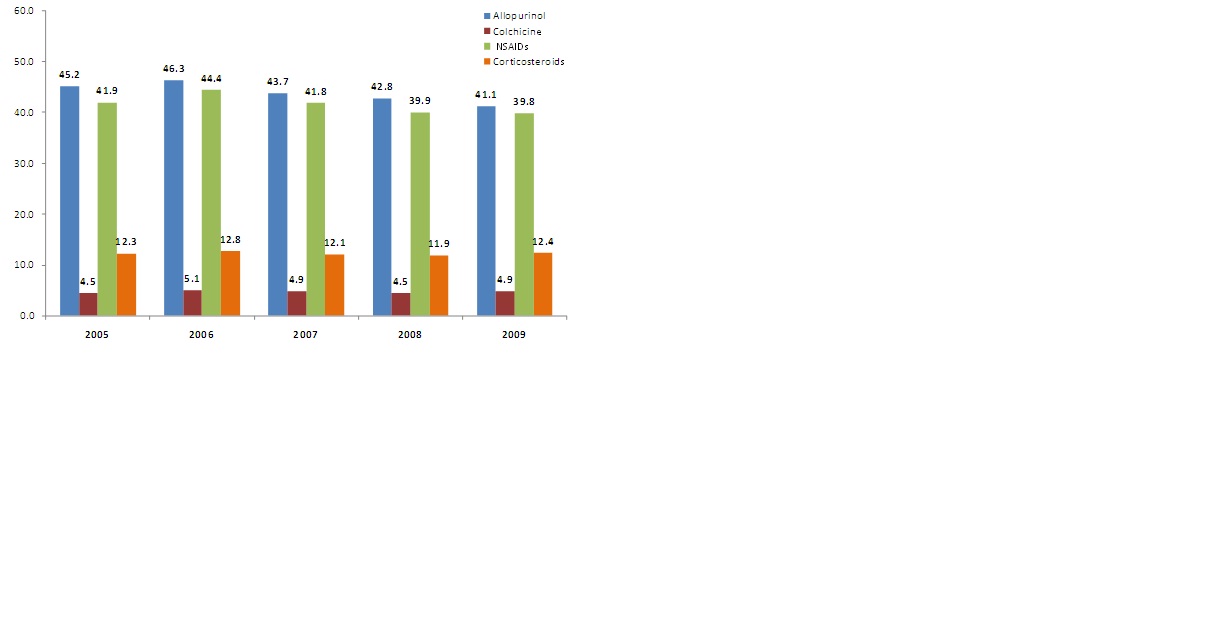Session Information
Session Type: Abstract Submissions (ACR)
Background/Purpose: Despite the increasing interest on gout, only few nationwide drug utilization studies have been conducted on this topic. The aim of this study was to investigate the Italian prescribing pattern of medications for gout in the years 2005-9
Methods: The data source of the study was the national Database of the Italian College of General practitioner, covering about 1.5 million patients from all around Italy. Patients with incident gout (years 2005-9) were identified using specific ICD9-CM codes and related key words for free text search. In this cohort of patients, we measured the yearly prevalence of use of the following drugs: allopurinol (ATC: M04AA01); colchicine (M04AC01); NSAIDs (M01A*). Moreover, systemic corticosteroids (H02*) were taken into account, because frequently used during acute attacks. Drugs not marketed in Italy, or not reimbursed by National Health System (probenecid, sulfinpirazone and benzbromarone) were not taken into account. For allopurinol rate and predictors of persistence and adherence to the treatment have been evaluated too.
Results: During the study period, 3,069 patients with incident gout were identified. Allopurinol prescription in these patients decreased from 45.2% in 2005 to 41.1% in 2009. Among drugs for the acute attack of gout, NSAIDs (from 41.9% in 2005 to 39.8% in 2009) were significantly more prescribed than colchicine (from 4.5% in 2005 to 4.9% in 2009). Corticosteroids were prescribed in a significant proportion of patients (from 12.3% in 2005 to 12.4% in 2009) during the whole study period. Only 22.7% of patients continued allopurinol after three months from the beginning of the therapy (6.6% after 6 months, 1.6% after one year). For allopurinol, the proportion of days covered (PDC) was on average equal to 39%. The proportion of patients with high adherence to the treatment (PDC >80%) increased with advancing age and was significantly higher in males. Hypertension, obesity, cerebrovascular diseases, congestive heart failure and sUA levels > 9mg/dl, enhanced allopurinol treatment adherence
Conclusion: to our knowledge, this is the first drug-utilization study on pharmacological management of gout in Italian general population. Our results were quite similar to that recently described in US population, although in this study the prevalence of colchicine (16.7%) and corticosteroids (21%) prescription was higher than those we observed. Our data show very low levels of persistence and adherence to allopurinol treatment; non-adherence was particularly common in younger patients, with lower serum urate levels and burden of comorbidities, as suggested in a recent survey. Clinicians should motivate low risk patients to increase the level of adherence to the treatment for the prevention of gout
Disclosure:
L. Cavagna,
None;
G. Trifirò,
None;
R. Caporali,
None;
P. Morabito,
None;
C. Ferrajolo,
None;
S. Pecchioli,
None;
M. Simonetti,
None;
G. Medea,
None;
C. Cricelli,
None;
A. Caputi,
None;
G. Mazzaglia,
None;
C. Montecucco,
None.
« Back to 2012 ACR/ARHP Annual Meeting
ACR Meeting Abstracts - https://acrabstracts.org/abstract/pharmacological-management-of-gout-in-italy-in-the-years-2005-2009-a-nationwide-population-based-study/

